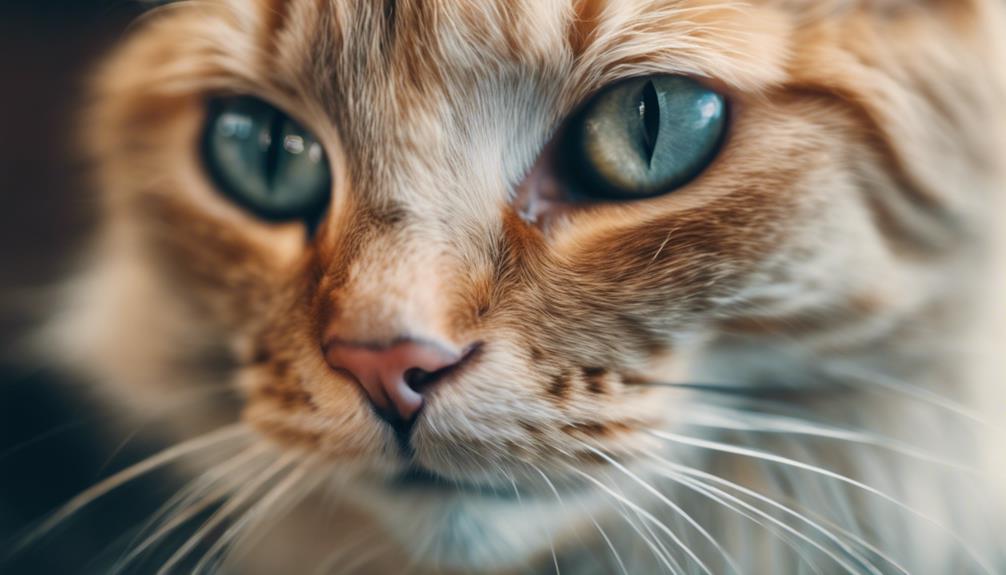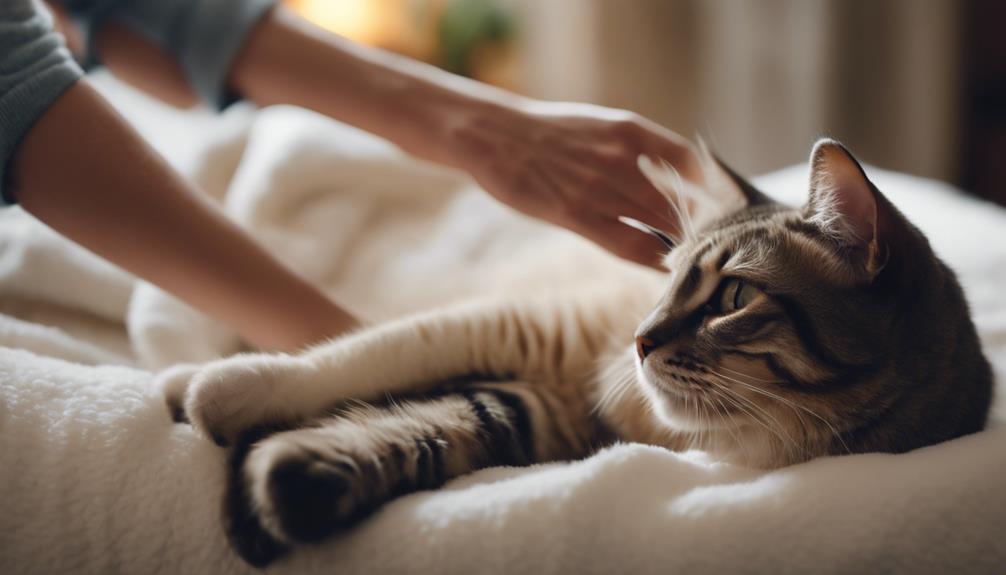Feline Hyperesthesia is a complex condition that can be perplexing for cat owners. From subtle behavioral changes to more pronounced physical symptoms, understanding the intricacies of this disorder is crucial for providing appropriate care to affected felines.
As we delve into the depths of Feline Hyperesthesia, unraveling its triggers and treatment modalities, a deeper comprehension of how to support and aid our furry companions emerges.
Stay tuned as we uncover the essential knowledge needed to navigate Feline Hyperesthesia and offer your kitty the best possible assistance in managing this challenging condition.
Key Takeaways
- Feline hyperesthesia presents with skin itching, tail thrashing, dilated pupils, and startle responses.
- Diagnosis involves dermatologic workup, medication trials, and neurological exams by a vet.
- Treatment includes behavior modification, management strategies, and medications like anticonvulsants and anti-anxiety drugs.
- Breeds like Abyssinian, Burmese, Persian, and Siamese are commonly affected by FHS after age two.
Recognizing Feline Hyperesthesia Symptoms
When observing a cat for signs of feline hyperesthesia, a vigilant and observant approach is essential to recognize the subtle manifestations of this episodic disorder. Feline hyperesthesia, also known as twitchy cat syndrome, presents with initial symptoms like itchy skin, tail thrashing, dilated pupils, rippling skin, and startle responses.
Additional signs may include excessive grooming, tail chasing, self-mutilation, frantic biting, increased vocalizing, and pain during petting. Episodes may be more frequent in the morning or late evening, with cats showing signs of tiredness or disorientation afterward. Understanding these symptoms is crucial for early detection and seeking appropriate veterinary care.
If you observe any of these behaviors in your cat, consulting a veterinarian promptly is recommended for a proper diagnosis and treatment plan.
Seeking Veterinary Diagnosis and Treatment
To effectively address feline hyperesthesia symptoms in cats, it is imperative to promptly seek veterinary consultation for accurate diagnosis and tailored treatment plans. Upon observing signs such as itchy skin, tail thrashing, dilated pupils, rippling skin, and startle responses, scheduling a vet visit is crucial.
The diagnostic process typically involves a thorough dermatologic examination, medication trials to alleviate itchiness, and neurological assessments to rule out underlying conditions. Treatment strategies may encompass behavior modifications, management techniques, and the administration of medications like flea treatments, corticosteroids, anticonvulsants, and anti-anxiety drugs.
Managing Feline Hyperesthesia Episodes

Addressing feline hyperesthesia episodes in cats requires a comprehensive approach that integrates behavioral management techniques and targeted medication interventions. Behavioral strategies aim to reduce stress and anxiety, such as creating a calm environment, providing interactive toys, and establishing a routine. Redirecting your cat's focus during episodes can help prevent escalation.
Medications like antianxiety drugs, anticonvulsants, or corticosteroids may be prescribed by a veterinarian to manage symptoms and improve your cat's quality of life. Additionally, maintaining a consistent schedule for feeding and playtime can help regulate your cat's behavior. Monitoring your cat for any triggers or patterns preceding episodes can aid in developing effective management strategies.
Understanding Feline Hyperesthesia Triggers
Understanding potential triggers for feline hyperesthesia is essential in effectively managing and addressing this complex feline disorder. Cats experiencing hyperesthesia may have specific triggers that can exacerbate their symptoms. These triggers can vary from cat to cat, but common ones include:
- Stressful Situations:
- Changes in the environment, new pets, loud noises, or unfamiliar visitors can trigger episodes.
- Physical Sensitivities:
- Overstimulation from petting, grooming, or certain textures can lead to heightened sensitivity in cats with hyperesthesia.
- Medical Issues:
- Underlying health conditions like allergies, skin irritations, or neurological disorders can act as triggers for feline hyperesthesia.
Supporting Your Cat Through Treatment

Supporting Your Cat Through Treatment involves implementing a comprehensive care plan tailored to address the specific needs of felines suffering from hyperesthesia. This plan may include a combination of behavioral modifications, environmental enrichments, and medications prescribed by a veterinarian.
It is essential to create a calm and stress-free environment for your cat to minimize triggers and alleviate discomfort. Regular veterinary check-ups to monitor progress and adjust treatment as needed are crucial.
Providing your cat with love, patience, and understanding during this challenging time is key to helping them cope with their condition. By working closely with your vet and staying dedicated to your cat's well-being, you can support them through their treatment journey and improve their quality of life.
Frequently Asked Questions
Can Feline Hyperesthesia Be Triggered by Environmental Factors or Stressors in a Cat's Environment?
Feline hyperesthesia can indeed be triggered by environmental factors or stressors in a cat's environment. Common triggers include changes in routine, loud noises, new pets, or sudden movements. Identifying and minimizing these stressors can help manage the condition effectively.
Are There Any Alternative or Holistic Treatment Options Available for Managing Feline Hyperesthesia?
Alternative and holistic treatment options for managing feline hyperesthesia may include acupuncture, herbal remedies, dietary changes, aromatherapy, and stress reduction techniques. These methods aim to alleviate symptoms and improve overall well-being in affected cats.
Can Feline Hyperesthesia Be a Hereditary Condition Passed Down Through Certain Cat Breeds?
Yes, feline hyperesthesia can be a hereditary condition passed down through certain cat breeds. Breeds like Abyssinian, Burmese, Persian, and Siamese are more commonly affected. Consult a vet for proper diagnosis and treatment.
Are There Any Specific Dietary Recommendations or Supplements That Can Help Alleviate Symptoms of Feline Hyperesthesia?
While dietary recommendations or supplements specifically targeting feline hyperesthesia symptoms are not widely documented, consulting a veterinarian for tailored advice is crucial. A balanced diet, stress reduction, and potential supplementation with omega-3 fatty acids might benefit some cats.
Is There Ongoing Research or Studies Being Conducted to Better Understand the Underlying Causes of Feline Hyperesthesia and Improve Treatment Options?
Ongoing research aims to enhance the comprehension of feline hyperesthesia's root causes and refine treatment modalities. Studies focus on unraveling the disorder's complexities to advance therapeutic approaches for improved management and care of affected cats.
Conclusion
In conclusion, understanding the symptoms, seeking veterinary diagnosis and treatment, managing episodes, identifying triggers, and providing support are essential aspects in effectively managing Feline Hyperesthesia in cats.
By being vigilant and proactive in addressing this condition, cat owners can ensure their feline companions receive the necessary care and support to improve their quality of life.
It is crucial to recognize the signs early and take prompt action to alleviate the distressing effects of Feline Hyperesthesia.




